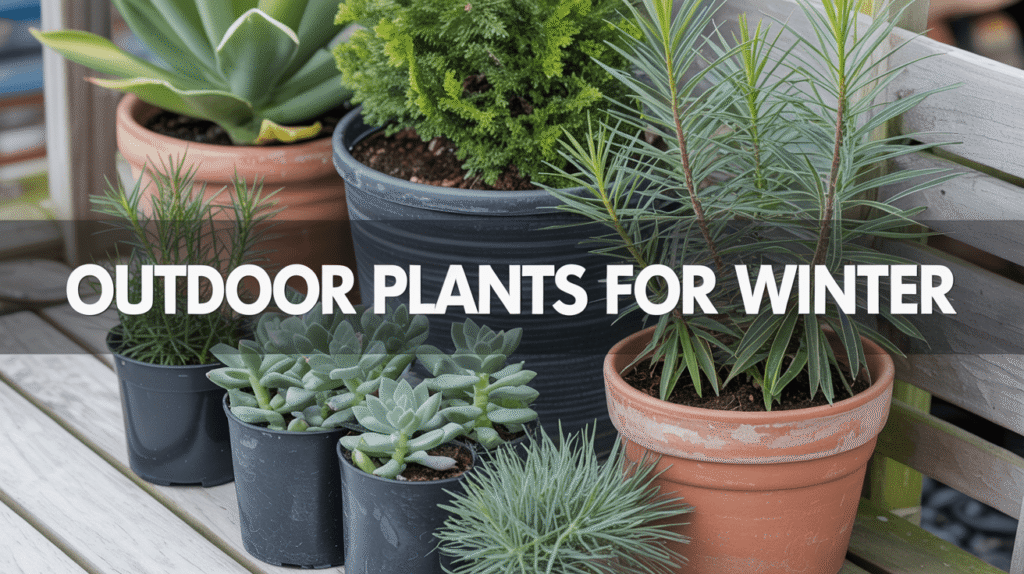When winter arrives, many gardens look bare and lifeless. The vibrant blooms of summer fade, and the lush greenery gives way to frost-covered lawns. But here’s the secret most beginner gardeners don’t know: your outdoor space doesn’t have to look dull during the colder months. With the right selection of outdoor plants for winter, you can add texture, greenery, and even bursts of color to your garden despite the chill.
From evergreen shrubs to hardy winter flowers, these plants are designed to thrive in low temperatures, resist frost, and brighten up your outdoor areas when most plants retreat. Whether you’re a seasoned gardener or just starting out, this guide will walk you through the best winter plants, care tips, and garden design ideas to ensure your outdoor space thrives all year round.
Why Grow Outdoor Plants for Winter?
1. Keep Your Garden Alive Year-Round
Winter doesn’t have to mean an empty garden. Cold-tolerant plants ensure greenery and blooms even in the frostiest months.
2. Boost Mood and Mental Wellbeing
Studies show that gardens filled with greenery during winter help combat seasonal blues and bring comfort during dark, chilly days.
3. Attract Wildlife
Winter plants with berries, seeds, or evergreen foliage provide food and shelter for birds and pollinators.
4. Low-Maintenance Beauty
Most winter plants are hardy and require little care once established, making them ideal for busy gardeners.
Characteristics of Winter-Resistant Plants
Not all plants can survive freezing conditions. Winter-hardy plants share a few key traits:
- Evergreen foliage: Keeps leaves throughout the cold months.
- Frost resistance: Can withstand freezing temperatures without damage.
- Deep roots or water storage: Help them access moisture when the ground is frozen.
- Compact growth: Reduces exposure to harsh winds.
Best Outdoor Plants for Winter
Here are some excellent plants to keep your garden beautiful and lively during winter:
🌿 1. Winter Jasmine (Jasminum nudiflorum)
- Bright yellow flowers bloom in late winter.
- Hardy shrub that grows well against walls or fences.
- Adds cheerful color during the darkest months.
🌿 2. Pansies
- Popular winter flowers available in vibrant shades of purple, yellow, and orange.
- Frost-tolerant and bloom even under snow.
- Perfect for pots, borders, or window boxes.
🌿 3. Hellebores (Christmas Rose)
- Evergreen perennials with delicate, rose-like flowers.
- Bloom from December to March.
- Excellent for shady spots and woodland gardens.
🌿 4. Evergreen Holly (Ilex aquifolium)
- Iconic glossy green leaves with bright red berries.
- A favorite for winter décor and attracting birds.
- Works well as hedges, borders, or specimen plants.
🌿 5. Heather (Erica carnea)
- Hardy groundcover with pink, purple, or white blooms in late winter.
- Adds color and texture to rocky or sloped gardens.
- Attracts bees when few plants are in bloom.
🌿 6. Ornamental Kale and Cabbage
- Striking foliage in shades of green, purple, and white.
- Thrives in containers and adds unique texture.
- Tolerates frost and snow.
🌿 7. Camellia
- Produces show-stopping blooms in shades of red, pink, and white.
- Evergreen shrub that flowers in late winter.
- Prefers acidic, well-drained soil.
🌿 8. Boxwood (Buxus sempervirens)
- Classic evergreen with dense foliage.
- Perfect for hedges, topiary, and structure in the garden.
- Withstands cold winds and snow.
🌿 9. Dogwood (Cornus)
- Noted for its vibrant red, yellow, or orange stems in winter.
- Adds architectural interest when other plants are bare.
- Low-maintenance and thrives in cold climates.
🌿 10. Snowdrops (Galanthus)
- Among the earliest flowers to bloom in winter.
- Small white bell-shaped flowers that push through snow.
- Symbolize hope and renewal.
Designing a Winter-Friendly Garden
Even in cold months, you can design a garden that looks alive and inviting. Here’s how:
1. Mix Evergreens and Flowering Plants
Combine hardy shrubs like boxwood or holly with flowering plants like pansies and hellebores for year-round interest.
2. Add Colorful Berries
Choose berry-producing shrubs such as holly or cotoneaster to feed birds and brighten up your space.
3. Use Containers and Pots
Potted winter plants like ornamental cabbage or pansies are easy to move and rearrange for maximum impact.
4. Create Layers of Texture
Mix tall shrubs, ground covers, and flowering perennials to build depth and dimension in your garden.
5. Light Up Your Garden
Use outdoor fairy lights or solar lamps to highlight evergreens and winter blooms, creating a magical winter wonderland.
Caring for Outdoor Plants in Winter
Even the toughest plants need a little care during winter. Follow these tips to help them thrive:
1. Protect Roots
Apply a thick layer of mulch around the base of plants to insulate roots from freezing temperatures.
2. Avoid Overwatering
Plants use less water in winter, so only water when soil is dry. Overwatering can lead to root rot.
3. Shield from Harsh Winds
Place pots against walls or fences, and use windbreaks to protect fragile plants.
4. Prune at the Right Time
Remove dead branches, but avoid heavy pruning until spring when plants are ready to grow again.
5. Use Frost Covers
Cover delicate plants with garden fleece or burlap during severe frosts.
Benefits of Outdoor Winter Plants
- 🌸 Seasonal Color: Flowers like pansies and hellebores keep your garden vibrant.
- 🌿 Year-Round Structure: Evergreens and shrubs provide texture even in snow.
- 🐦 Wildlife Support: Berries and seeds help feed birds and pollinators.
- 🏡 Enhanced Curb Appeal: A well-kept winter garden adds charm to your home.
- 💧 Low Maintenance: Winter-hardy plants often need little watering or upkeep.
Step-by-Step Guide: Planting a Winter Garden
- Assess Your Climate: Check your USDA Hardiness Zone or local climate to choose suitable plants.
- Choose Hardy Plants: Select evergreens, winter flowers, and frost-resistant shrubs.
- Prepare the Soil: Add compost and ensure proper drainage to prevent waterlogging.
- Plant in Fall: Give plants time to establish roots before winter sets in.
- Mulch and Protect: Add mulch and frost covers as temperatures drop.
- Maintain Lightly: Water sparingly, prune gently, and enjoy your garden’s winter beauty.
Frequently Asked Questions (FAQ)
1. What plants survive outdoors in winter?
Evergreens like boxwood, holly, and juniper, along with winter flowers like pansies, hellebores, and snowdrops, thrive in cold months.
2. Can I grow outdoor plants in pots during winter?
Yes! Pansies, ornamental cabbages, and small evergreens grow well in pots with good drainage and some frost protection.
3. How do I protect my plants from frost?
Mulch the soil, use frost covers, and move potted plants closer to sheltered areas.
4. Do winter plants need fertilizer?
Most winter plants grow slowly and don’t need much feeding. Apply a slow-release fertilizer in early spring.
5. Can I have a colorful garden in winter?
Absolutely! Plants like camellias, pansies, dogwood, and ornamental kale bring vibrant color to cold landscapes.
Conclusion
Winter doesn’t have to mean dull gardens or bare landscapes. With the right outdoor plants for winter, you can enjoy evergreens, colorful blooms, and vibrant textures that bring warmth and beauty to even the coldest months. From classic holly with bright red berries to cheerful pansies and the delicate snowdrop, these plants prove that winter gardens can be just as enchanting as summer ones.
🌿 Ready to transform your garden into a year-round sanctuary? Discover more plant guides, design ideas, and expert tips at Green Plant Zone—your trusted guide to thriving gardens in every season.

Hi, I’m the creator of Green Plant Zone, a space dedicated to plant lovers. I share tips on indoor and outdoor gardening, plant care guides, and eco-friendly living. My mission is to help you grow healthier, happier plants and bring more greenery into everyday life.
